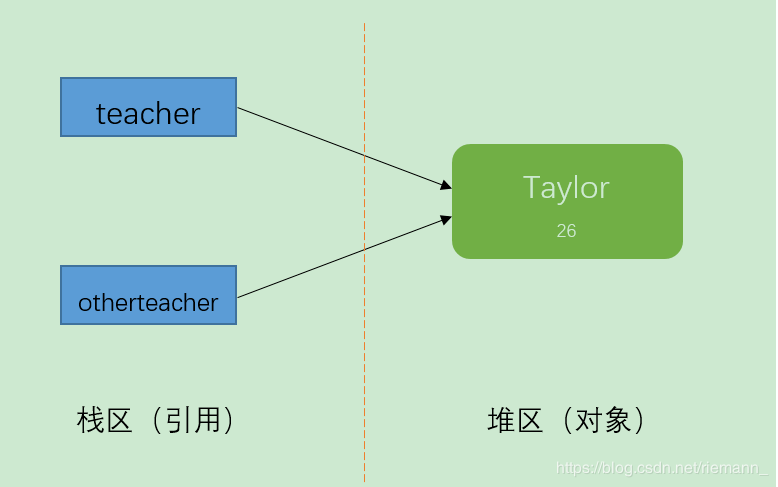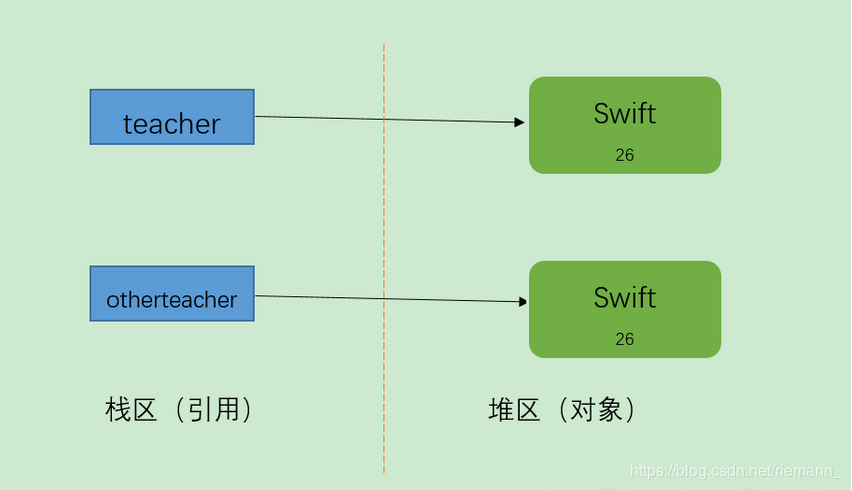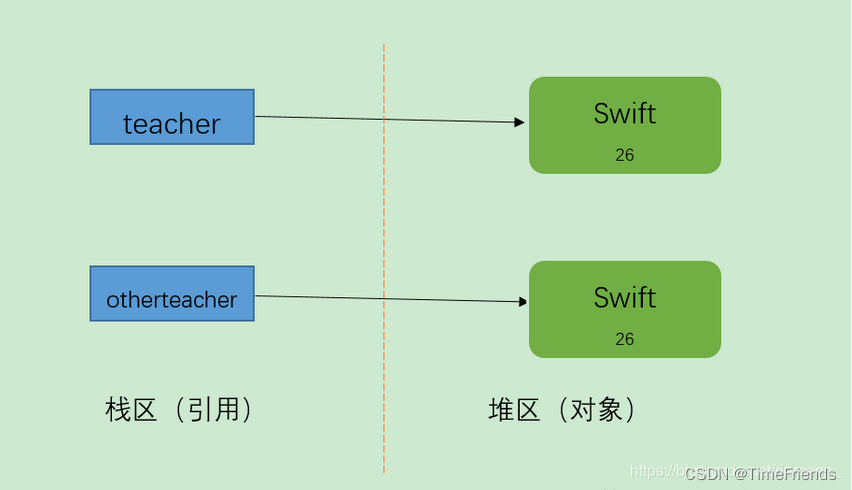一、拷贝的引入
(1)、引用拷贝
创建一个指向对象的引用变量的拷贝。
Teacher teacher = new Teacher("Taylor",26);
Teacher otherteacher = teacher;
System.out.println(teacher);
System.out.println(otherteacher);
输出结果:
blog.Teacher@355da254
blog.Teacher@355da254
结果分析:由输出结果可以看出,它们的地址值是相同的,那么它们肯定是同一个对象。teacher和otherteacher的只是引用而已,他们都指向了一个相同的对象Teacher(“Taylor”,26)。这就叫做引用拷贝。

(2)、对象拷贝
创建对象本身的一个副本。
Teacher teacher = new Teacher("Swift",26);
Teacher otherteacher = (Teacher)teacher.clone();
System.out.println(teacher);
System.out.println(otherteacher);
输出结果:
blog.Teacher@355da254
blog.Teacher@4dc63996
结果分析:由输出结果可以看出,它们的地址是不同的,也就是说创建了新的对象, 而不是把原对象的地址赋给了一个新的引用变量,这就叫做对象拷贝。

注:深拷贝和浅拷贝都是对象拷贝
二、浅拷贝
(1)、定义
被复制对象的所有变量都含有与原来的对象相同的值,而所有的对其他对象的引用仍然指向原来的对象。即对象的浅拷贝会对“主”对象进行拷贝,但不会复制主对象里面的对象。”里面的对象“会在原来的对象和它的副本之间共享。
简而言之,浅拷贝仅仅复制所考虑的对象,而不复制它所引用的对象
(2)、浅拷贝实例
package com.test;
public class ShallowCopy {
public static void main(String[] args) throws CloneNotSupportedException {
Teacher teacher = new Teacher();
teacher.setName("riemann");
teacher.setAge(27);
Student2 student1 = new Student2();
student1.setName("edgar");
student1.setAge(18);
student1.setTeacher(teacher);
Student2 student2 = (Student2) student1.clone();
System.out.println("拷贝后");
System.out.println(student2.getName());
System.out.println(student2.getAge());
System.out.println(student2.getTeacher().getName());
System.out.println(student2.getTeacher().getAge());
System.out.println("修改老师的信息后-------------");
// 修改老师的信息
teacher.setName("Games");
System.out.println(student1.getTeacher().getName());
System.out.println(student2.getTeacher().getName());
}
}
class Teacher implements Cloneable {
private String name;
private int age;
public String getName() {
return name;
}
public void setName(String name) {
this.name = name;
}
public int getAge() {
return age;
}
public void setAge(int age) {
this.age = age;
}
}
class Student2 implements Cloneable {
private String name;
private int age;
private Teacher teacher;
public String getName() {
return name;
}
public void setName(String name) {
this.name = name;
}
public int getAge() {
return age;
}
public void setAge(int age) {
this.age = age;
}
public Teacher getTeacher() {
return teacher;
}
public void setTeacher(Teacher teacher) {
this.teacher = teacher;
}
public Object clone() throws CloneNotSupportedException {
Object object = super.clone();
return object;
}
}
输出结果:
拷贝后
edgar
18
riemann
27
修改老师的信息后-------------
Games
Games
结果分析:两个引用student1和student2指向不同的两个对象,但是两个引用student1和student2中的两个teacher引用指向的是同一个对象,所以说明是浅拷贝。

三、深拷贝
(1)、定义
深拷贝是一个整个独立的对象拷贝,深拷贝会拷贝所有的属性,并拷贝属性指向的动态分配的内存。当对象和它所引用的对象一起拷贝时即发生深拷贝。深拷贝相比于浅拷贝速度较慢并且花销较大。
简而言之,深拷贝把要复制的对象所引用的对象都复制了一遍。
(2)、深拷贝实例
package com.test;
public class DeepCopy {
public static void main(String[] args) throws CloneNotSupportedException {
Teacher2 teacher = new Teacher2();
teacher.setName("riemann");
teacher.setAge(27);
Student3 student1 = new Student3();
student1.setName("edgar");
student1.setAge(18);
student1.setTeacher(teacher);
Student3 student2 = (Student3) student1.clone();
System.out.println("拷贝后");
System.out.println(student2.getName());
System.out.println(student2.getAge());
System.out.println(student2.getTeacher().getName());
System.out.println(student2.getTeacher().getAge());
System.out.println("修改老师的信息后-------------");
// 修改老师的信息
teacher.setName("Games");
System.out.println(student1.getTeacher().getName());
System.out.println(student2.getTeacher().getName());
}
}
class Teacher2 implements Cloneable {
private String name;
private int age;
public String getName() {
return name;
}
public void setName(String name) {
this.name = name;
}
public int getAge() {
return age;
}
public void setAge(int age) {
this.age = age;
}
public Object clone() throws CloneNotSupportedException {
return super.clone();
}
}
class Student3 implements Cloneable {
private String name;
private int age;
private Teacher2 teacher;
public String getName() {
return name;
}
public void setName(String name) {
this.name = name;
}
public int getAge() {
return age;
}
public void setAge(int age) {
this.age = age;
}
public Teacher2 getTeacher() {
return teacher;
}
public void setTeacher(Teacher2 teacher) {
this.teacher = teacher;
}
public Object clone() throws CloneNotSupportedException {
// 浅复制时:
// Object object = super.clone();
// return object;
// 改为深复制:
Student3 student = (Student3) super.clone();
// 本来是浅复制,现在将Teacher对象复制一份并重新set进来
student.setTeacher((Teacher2) student.getTeacher().clone());
return student;
}
}
输出结果:
拷贝后
edgar
18
riemann
27
修改老师的信息后-------------
Games
riemann
结果分析:
两个引用student1和student2指向不同的两个对象,两个引用student1和student2中的两个teacher引用指向的是两个对象,但对teacher对象的修改只能影响student1对象,所以说是深拷贝。
关于Java深拷贝和浅拷贝区别,你学废了么?
真诚地邀请您加入我们的大家庭.
在这里不仅有技术知识分享,还有博主们之间的互帮互助
不定期发红包,每月更有抽奖环节,游戏机和实体书相赠(包邮)
让我们抱团取暖,抱团内卷.打造美好C站.期待您的加入.
备注 : CSDN-xxxxxx (xxxxxx代表你csdn的昵称)